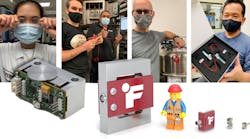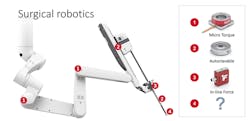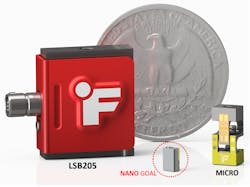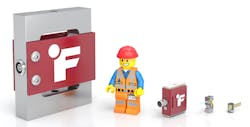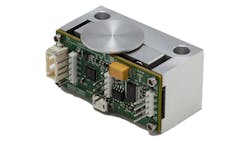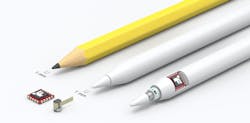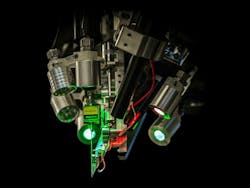At a Glance:
- Maciej (“MJ”) Lisiak, a micro miniaturization team leader at Futek Advanced Sensor Technology, Inc. discusses the next generation of sensor design and technology.
- Back in 2018, Lisiak had the goal of shrinking the envelope of the Futek’s Jr S-Beam, a sugar cube-sized sensor, down to the size of a tip of a match.
- Lisiak discusses how Futek’s Nano platform continues to support the next generation of smart surgical tools.
Designing miniature sensors for the medical industry is no easy feat. But it’s a challenge Maciej (“MJ”) Lisiak is willing to take on any given day.
As the Micro Miniaturization team leader at Futek Advanced Sensor Technology, Inc., Lisiak is fixated on creating some of the smallest sensors in the marketplace. Developing sensors for unique applications for mobile electronics, redefining the product aesthetics and bringing smart integration and out-of-the-box streamlining approaches to support high scalability are par for the course in his work environment.
“My team and I have been able to continuously reinvent and improve sensor technology and now have multiple patents under our belts,” said Lisiak, whose career started out as an intern design engineer for a high-performance motorized surfboard company.
When Lisiak joined Futek back in 2013, his intention was to build up an electronics manufacturing foundation. “I was very driven to get hands-on experience with real-world engineering and to further grow my passion for mechanical design,” he said.
The opportunity came with a payoff. “My team and I have been able to continuously reinvent and improve sensor technology and now have multiple patents under our belts,” he said.
In the following Q&A, Lisiak shares insights on how his team at Futek’s Micro Division is focused on pushing the boundaries of sensor miniaturization.
Machine Design: Sensors have come a long way in synthesizing data quickly. What would you say are the opportunities for MedTech applications based on FUTEK’ s sensor technologies?
Maciej Lisiak: When it comes to MedTech applications, the key to our success lies in Futek’s solution mindset. There is no sensor success story without low-noise signal conditioning electronics and data acquisition software. The fact that we offer these end-to-end solutions (sensor, electronics, software) makes our platform very unique, as we have the know-how and capability to bring these three holy grails of sensing technology under one umbrella.
Please keep in mind we have multiple mechanical design and manufacturing teams focusing on different aspects of sensor designs including force, torque, pressure [and] multi-component applications.
My team, the Micro Division, is focused on pushing the boundaries of sensor miniaturization. This is key to enabling the next generation of Med-Tech devices, as micro-miniaturization allows us, for example, to literally push sensing capabilities to the tip of surgical tools. The closer you can integrate the sensing capabilities to the mechanical interaction zone, the more accurately you can control the process, allowing the sensor to collect clean, relevant data.
MD: Please give us an overview of your team’s challenges or constraints in developing miniaturized sensors while developing the nano sensors to support medical devices.
ML: Our first major challenge was back in 2018, when we had the goal of taking our Jr S-Beam, a sugar cube-sized sensor that had set an industry benchmark, and squeezing its envelope down to the size of a tip of a match. It seemed unrealistic in the early days of development.
The first obstacle to overcome was really the mindset; first we had to believe that this was possible to accomplish, and then we had to get top-level management’s backing for this “mission impossible,” which would challenge the industry’s status quo.
From the very beginning we knew that the nanosensor represented a huge potential technological window that we were trying to push open. The first Micro Gen 1 and Nano Gen 2 were key steppingstones in terms of miniaturization, with us delivering the first functional 4 mm footprint sensor.
Then we had to solve the reliability and high scalability aspects in order to successfully support MedTech applications. Having a multi-disciplinary team with design and manufacturing engineers working closely together was crucial in allowing us to optimize the design for a streamlined manufacturing process.
MD: Tell us about the evolution of the S-beam design. How has this technology evolved over time? What is the smallest design configuration Futek has achieved to date? What are its latest capabilities?
ML: The backbone of the Futek Micro division is the evolution of the original Jr S-Beam, LSB200 in-line force sensor, which became an instant benchmark for OEM applications, including in the medical industry, thanks to its miniaturized envelope and overload stop capabilities.
It really was a game-changer back in early 2000, when conventional sensors were standing a few inches tall. The Jr S Beam broke the code with its 0.75-in. tall envelope and capability to withstand 1,000% overload without failure in both tension and compression—which was unheard of in the industry at the time.
Over the past several years, the evolution of the Jr S-Beam has continued, as we have developed fatigue-rated constructions that allow the sensor to maintain its performance while crossing 100 million full capacity double directional cycles without failure.
We have expanded the capabilities of the Jr S-Beam further by adding connectorization, smart recognition, temperature compensation and dual bridge redundancy for the most critical medical applications.
What followed the Jr S-Beam was the introduction of the nanosensor platform, where we pushed the envelope down to a 4 mm × 4 mm footprint.
MD: Describe some of the categories of Futek sensors used in motion control applications.
ML: My area of expertise is in miniature force and pressure sensors, but Futek has design and manufacturing teams that focus strictly on rotary torque and reaction torque sensors, including micro torque sensing solutions.
A great example of a motion control application here is a surgical robotic arm, with joint-embedded Futek reaction torque sensors that allow for high-precision control, emulating the smooth movement of the surgeon’s hand. This integration aspect into the robotic joint application has pushed our design teams to reduce the overall torque sensor size by 60% compared to conventional solutions.
Rotary Torque sensors are highly complex devices, also heavily utilized in motion control applications, and can provide not only torque, but also position and RPM feedback. Ultra-tight tolerance machining capabilities are a key aspect of building high-performance torque sensors. Futek has impressive in-house machining and inspection capabilities down to a micron accuracy to support some of the most critical applications.
Another area of our expertise is developing multi-component sensors. One of its most advanced forms are six-degrees-of-freedom sensors that provide x, y, z force and x, y, z torque feedback. This allows for a fully dynamic vector definition in three-dimensional space.
One of our most famous multi-component sensors was designed and manufactured for NASA’s Mars Curiosity Rover, it was mounted on the robotic drill arm to control sample excavation on the planet’s surface.
MD: What role does Futek play in requests for custom design of miniaturized sensors? Can you describe an example/use case?
ML: We have thousands of off-the-shelf standard products in stock available for immediate delivery, but in cases where a custom sensor is necessary for a very unique application, our engineering teams are ready to design and develop an ideal solution.
In such cases, our teams usually get involved in the early stage of the customers’ development process to allow us to provide the most effective sensing system. This process involves a tight collaborative effort between our engineering teams. We take great pride in going above beyond and pushing ourselves to exceed the customer’s expectations in terms of performance, miniaturization and integration capabilities.
MD: What are the ongoing challenges for miniaturizing sensors?
ML: When it comes to our quest of furthering sensor miniaturization in order to enable the next generation of MedTech products and other emerging technologies, there is no end in sight.
I like to compare the challenges of miniaturization to going from dynamics to quantum physics. As you start pushing that envelope, everything changes and needs to be revisited based on the new laws that start to apply outside the status quo.
It is not just about scaling things down, it is about completely reinventing the design approach, instrumentation, product handling and fabrication processes. It is a chain reaction affecting everything from inspection methods to manufacturing and testing equipment.
MD: Look to the future: How are smart sensors getting smarter? What technologies are sensors replacing? (Dataloggers?) And, in what ways are the development of other technologies, such as robotics, affecting the development of sensors?
ML: While general, manufacturing-type automation has been around for over half a century, we have officially entered an era of smart automation allowing a robotic system to sustain its operation even under unpredictable circumstances.
This is where the sensing aspect comes in, allowing for the force feedback that data collection AI and decision-making algorithms derive from. Surgical robotics is probably one of the most mission-critical forms of automation when it comes to process control, system response and resolution.
MedTech is very unique in terms of its product requirements, such as the necessity for a sensor to survive a sterilization process involving 137°C saturated steam and high-pH wash environment, which is very challenging for any electronic device. This is a perfect example of Futek’s adaptability to the industry requirements with some of our patented sensor products being capable of surviving even thousands of sterilization cycles exceeding all industry standards.
